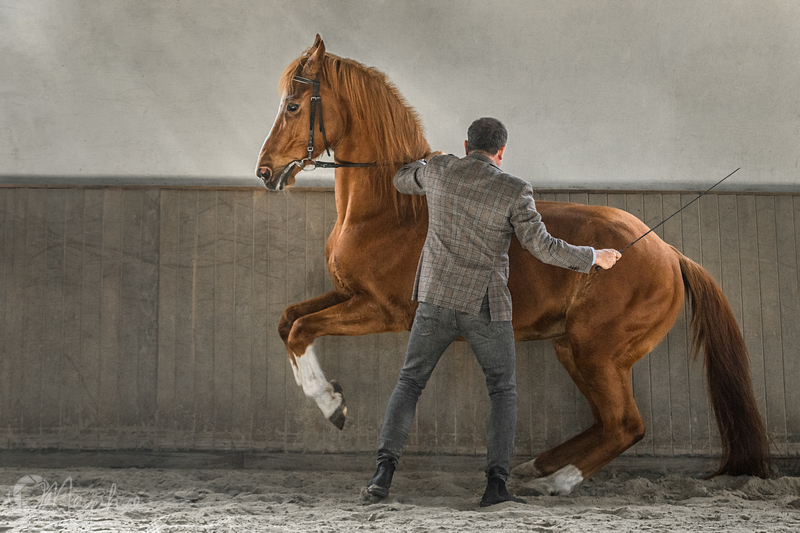
All this is far from reality: I like to ride horses, I like to canter, but only in a very prepared way. The reason for the preparation is simple: I look for harmony. When everything falls into place, it hits the rider with such joy that it causes hours of almost otherworldly delight. This is not new for anyone, as the Arab saying is well known, a man feels good in three places: in the arms of his beloved, in his library and on the back of his horse.
However, harmony is not only beneficial for me but also for the horse. In other words, I want my riding, its style, its manner, its intensity to result in very long term use. I mean that I want to use my horse when he’s 22-25, but even when he’s 27 years old. My daily work is aimed at maintaining and preserving his physical and mental health for a very long time.
Of course, this requires competence, and competence can be learnt from a master. At least that's the easiest way. However, a master is hard to find. And there are many reasons for this. First of all, it is difficult to decide who the master is. Many people rate trainers based on competition results. I don't think they should, since competition results greatly depend on horses. There is an ideal saddle horse, which reacts correctly to every rider's aid, even the wrong one. So, performance does not necessarily answer the master question. Then what? The answer is simple, a master can only be a master's student. I recommend that you only learn quality horsemanship from someone who can tell you who his master is and who he personally acquired their skills from. My master is Bent Branderup.
- Branderup's predecessor was Neindorff
- Neindorff's predecessor was Wäjten
- Wäjten's predecessor was Lörke
- Lörke's predecessor was Bürkner
- Bürkner's predecessor was Heydebreck
- Heydebreck's predecessor was Plinzner
- Plinzner's predecessor was Steinbrecht
- Steinbrecht's predecessor was Seeger
- Seeger's predecessor was Maximillien Weyrother
- Maximilien Weyrother's predecessor was Adam Weyrother
- Adam Weyrother's predecessor was Guérinière
- Guérinière's predecessor was Vendeuil
- Vendeuil's predecessor was Pluvinel
- Pluvinel's predecessor was Pignatelli
- Pignatelli's predecessor was Grisone
- Grisone's predecessors were master horsemen who fled to Italy from the Turkish armies occupying Byzantium, Istanbul today.
You can primarily learn vision from the master. The idea of what exactly a well-trained horse looks like. The idea will guide the thought of what we accept as good or what we consider bad. For example, in modern dressage it is completely accepted if a horse walks in a pass. I find it unacceptable and even though I see that the most celebrated riders walk with the wrong leg order. Even if public culture shoves this in my face, I will not accept it because my idea about a well-trained horse is different.
On the other hand, you can learn the feeling from the master. The biggest challenge in riding is that you can’t see the horse from the saddle. Riders can only perceive through their feelings how the horse's activity compares to their vision.
Feeling can be learnt. But, of course, you can only learn the right feeling from a well-trained horse. The feeling of balance, for example, can't be "found" on a horse without sufficient balance. Obviously, what the horse doesn’t produce can’t be felt either. And if the feeling doesn't come, how could the rider know what's happening underneath?
Thirdly, you can learn the technique from the master, that is what the rider should do if the rider's feeling indicates a situation different from the vision.
In my search for harmony, my goal is to ride only with my seat, and the communication between me and my horse is only through body language. This is the essence of high school. I'm afraid to say that I cultivate high school, although that’s the truth. My fear is that it’d scare many. High school doesn’t mean that the most difficult tasks of horse training are practiced from morning to night, but that the goal is to ride using a seat. That’s why, if I perform a walk-trot transition with using a seat, it’s high school, but no matter what special task the rider is doing, if he constantly needs to use reins and boots, then I call it campagne school. Campagne school cultivates a simplified version of communication with the horse.
When those Crusaders in the XII. century who reached the Holy Land could taste the spices of the East back in Europe, life became boring because food lacked spices. So, campagne school isn’t enough for me, because I ‘tasted’ high school and I can’t forget the feeling. Of course, those who have completed high school can also ride in campagne style, but the opposite isn’t the case. Campagne style was invented exactly to allow a simplified way of communication; riders and horses could be trained to an acceptable level in a relatively short time. But I want more than that for myself and my horses.

